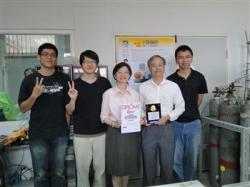May 7 2010
The NCKU research team, comprising experts and students specializing in Chemical Engineering and Microelectronics, has received a gold medal for designing an innovative hydrogen leak detection system called the Semiconductor Transistor-Type Hydrogen Sensor.
 The NCKU research team
The NCKU research team
The event took place at the 38th International Exhibition of Inventions of Geneva.
The sensor has been uniquely designed that it can instantly detect a hydrogen leak having a minimum concentration of five part per million (ppm). The device can be operated with less than 50 mW power, which helps in saving significant amounts of carbon and power. The sensor is also compact and lightweight.
According to Wen-Chau Liu, Professor of Department of Electrical Engineering and Institute of Microelectronics, standard transistors are normally made of silicon materials, and cannot withstand extreme temperatures and harsh conditions. They are also susceptible to radiation and acid corrosion. He informed that the new Semiconductor Transistor-Type Hydrogen Sensor is made from palladium and platinum materials, which imparts high thermal stability. The sensor can adapt to normal temperatures and temperatures as high as 120oC. The device is also resistant to chemicals and radiations. Liu further stated that the sensor can be used in Micro Electro-Mechanical Systems (MEMS), Integrated Circuit (IC) and communication devices.
The sensor can protect people working in chemical factories, aerospace and automotive industrial fuel cells and as well as in medical device and semiconductor manufacturing processes where hydrogen leak monitors and hydrogen input monitors are primarily used.
Liu further started that winning the gold medal was achieved through the collective effort of Professor Huey-Ing Chen and the students. He informed that the NCKU team had utilized water to generate hydrogen, which helped in enhancing the sensor’s operating functions.
Professor Huey-Ing Chen informed that the team got its inspiration from electrolyzed water and solar energy which can be used to produce hydrogen. The team utilized the electrolyzed water and a battery to generate hydrogen. After the water generates hydrogen, the same is directed into the sensor. The sensor immediately lets out sound and light to trigger an early warning sign.